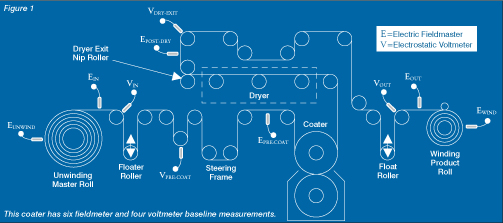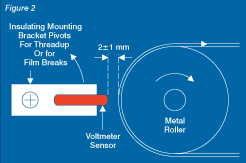Static Specified
- Published: April 01, 2009, By By Kelly Robinson, Electrostatic Answers LLC
Static must be controlled in many manufacturing operations, and new, more complex products require even lower static to ensure effective converting. Multilayered films formed by coextrusion and lamination have engineered surfaces that are sensitive to static charge and electrical discharges. Products on flexible substrates with integrated electronics, such as RFIDs and printed electronics, bring electrostatic discharge (ESD) sensitivity to roll-to-roll manufacturing. Biologically active coatings for clinical diagnostic products and for a new generation of sensors require excellent static control.
Static performance should be specified and designed into new equipment, and it should be a deliverable when developing a new product. On existing machines, good performance is achieved after solving costly static problems to restore reliable operation. To prevent most future static problems and to prepare to solve the few issues that will occur, take baseline static measurements when accrediting a new machine and when starting up a restored operation. Maintain that good performance during normal production by routinely monitoring static.
Here are two keys to staying ahead of static problems in film conveyance:
- Baseline Measurements
Collect and document baseline electrostatic fieldmeter and noncontacting electrostatic voltmeter measurements. Use these measurements to verify normal operation and identify sources of static when problems occur.
- Monitor Static on Incoming and Outoing Material
Be sure your incoming material is acceptable and that your customers will receive good product.

Baseline Measurement
Baseline static measurements verify that your process is running properly. For example, Figure 1 depicts the threadup for a simple coater with several common conveyance elements. A float roller controls the unwinding tension; a steering frame guides the film into the coater; a nip roller at the dryer exit secures the coated film; and a float roller controls the winding tension. The winder uses a lay-on roller to improve wound roll integrity.
Ten baseline measurements characterize the static performance of this coater (E=electric fieldmeter and V=electrostatic voltmeter).

- EUNWIND
Unwinding film often generates high levels of static when the outer lap is peeled from the stockroll. Find this static source by measuring the electric field at the surface of the unwinding stockroll. The electric field near the unwinding stockroll must be measured using a handheld electrostatic fieldmeter because diameter of the stockroll changes as film unwinds. Readings are taken either at the center of the film or on the sidewall of the unwinding roll. Either or both locations are commonly used for baseline measurements. Document the location used so that future measurements can be taken consistently.
- EIN
Measure the electric field on the film span between the unwinding stockroll and the first roller to verify that incoming material from your supplier has low static. The electric field on this span must be taken using a handheld electrostatic fieldmeter because the diameter of the stockroll changes as film unwinds. Readings are taken at the center of the film.
- VIN
Measure the film surface potential on the first metal roller after the unwinder to verify that your incoming material has low static. Figure 2 shows how to measure the surface potential of the film using a noncontact electrostatic voltmeter. The sensor is secured in an insulating mounting bracket so it is about 2 mm from the surface of the film wrapped on a smooth metal roller. The mounting fixture should be designed so the sensor can rotate away from the film for threadup or in the event of a film break. The sensor should be located at the center of the film.
- VPRE-COAT
Measure the potential of the film surface to be coated to ensure the coating will be consistent and uniform. Similar to measuring VIN, use a noncontact electrostatic voltmeter. The sensor usually is located at the center of the film, though additional sensors often are located near each edge to monitor the surface potential across the full width of the film for high-value coatings.
- EPRE-COAT
The electric field just before entering the coater is a key baseline measurement, and it is an important safety measurement for solvent coaters. The sensor used to measure the electric field is permanently mounted so it is about 10 mm from the film. The measurement location is the center of the film on a span midway between idler rollers. The sensor may be located on either side of the film. For solvent coating operations, this measurement should be monitored by the machine control system so the operation can be E-stopped if the field exceeds about +/-4 kV/cm +/-10 kV/in.) to prevent static sparks from igniting solvent vapors in the coater.
- EPOST-DRY
The electric field measured on a film span just downstream from the dryer exit verifies that the coating and drying operations are functioning properly. The sensor can be either permanently mounted or handheld. Readings are taken at the center of the film on a free span midway between idler rollers. For handheld readings, document the location used so future measurements can be taken consistently.
- VDRY-EXIT
The surface potential on the uncoated surface of the film exiting the dryer is a key baseline measurement. A nip roller often is used at the exit of the dryer for consistent film conveyance and tension control. Voltage VDRY-EXIT detects the high static often generated by the dry exit nip roller. The sensor should be located at the center of the film.
- EOUT
Measure the electric field on the film span between the last roller and the winding stockroll to verify that the outgoing material to be delivered to your customer has low static. The electric field on this span must be taken using a handheld electrostatic fieldmeter because diameter of the stockroll changes as film unwinds. Readings are taken at the center of the film. These measurements may be reported on the Quality Assurance Report provided to your customer.
- VOUT
Measure the film surface potential on the last metal roller before the winder to verify that the outgoing material has low static. The sensor should be located at the center of the film. These measurements may be reported on the Quality Assurance Report provided to your customer.
- EWIND
The lay-on roller used to improve winding often generates high levels of static on the winding roll. Find this static source by measuring the electric field near the winding stockroll.
The electric field near the winding stockroll is taken manually using a handheld electrostatic fieldmeter because diameter of the stockroll changes as film winds. Readings are taken either at the center of the film or on the sidewall of the unwinding roll. Either or both locations commonly are used for baseline measurements. Document the location used so future measurements can be taken consistently.
Monitor Static on Incoming & Outgoing Material

Prevent problems caused by static on incoming material by specifying acceptable levels of static in your purchase contracts and by monitoring static delivered to your process. Purchase contracts for raw materials should include a specification on static charge similar to Figure 3.
The electric field EIN is measured on the film span between the unwinding roll and the first roller. The voltage VIN is measured on the first metal roller after the unwinding roll. Measure the acceptable levels for EIN and VIN for your process when it is running well so you ask your supplier only for what you really need.
For the coater threadup shown in Figure 1, VIN and EIN often are difficult to measure because the unwinder is congested and operators are not permitted in this area when the machine is running. It is acceptable to measure VIN and EIN a few rollers downstream of the unwinder. Static charging from a couple of metal idler rollers is not significant.
Similarly, VOUT and EOUT often are difficult to measure because the winder is congested and operators are not permitted in this area when the machine is running. It is acceptable to measure VOUT and EOUT a few rollers upstream of the winder.
Good static control is needed to manufacture many current products. New products will need even better static control. Baseline measurements taken using electric fieldmeters and noncontacting electrostatic voltmeters verify that your process is running properly. In your purchase contracts, specify that raw materials have low static and monitor static on incoming materials. Finally, be sure that your customers receive acceptable product by monitoring static on your outgoing materials.
Supplier Info
Electrostatic Answers | www.electrostaticanswers.com
Circle 307 or visit www.freeproductinfo.net/pffDr. Kelly Robinson is president of Electrostatic Answers, an engineering consulting company that provides electrostatic problem-solving expertise. Kelly has more than 27 years of industrial experience including client work for four Fortune 500 companies. His patents and articles contribute to roll-to-roll manufacturing, electronic displays, copier technology, and electrostatic instrumentation. Contact him at 585-425-8158; This email address is being protected from spambots. You need JavaScript enabled to view it..
The views and opinions expressed in Technical Reports are those of the author(s), not those of the editors of PFFC. Please address comments to the author(s).




